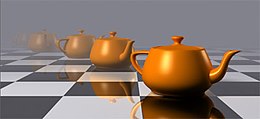Utah teapot

The so-called Utah teapot (English: Utah teapot ) is one of the oldest and best-known 3D models of computer graphics . It is a simple surface model of a teapot in which the inner cavity cannot be seen. Martin Newell developed it in 1975 as part of his computer graphics research at the University of Utah .
origin

Newell needed a simple mathematical model of a commodity for his work, and his wife's Melitta teapot seemed suitable: The shape has some properties that were necessary for the purposes at the time; it is round, has saddle points and concave elements (especially the hole in the handle) and looks quite appealing even without an elaborate surface texture .
After Newell developed a description of the teapot as a Bézier surface , other research groups adopted the model for their work, making the object a reference model for computer graphics.
Newell donated the original to the Computer History Museum in California, where it is placed in the permanent exhibition. The teapot was manufactured in the Friesland porcelain factory in Rahling , Lower Saxony, which manufactured under the Melitta brand from 1954 to 1991 . The teapot is still produced today.
distribution
Over the years, versions of the teapot have been regularly presented in computer magazines, and well-known 3D software products today mostly contain example images or scenes that contain the teapot. The OpenGL graphics library GLUT even contains a function called glutSolidTeapot () and the 3D animation program 3d Studio Max still contains the teapot as a basic construction object in a plane with the cylinder and the cuboid.
In the meantime the teapot has developed into a kind of running gag in the computer graphics scene and the model was "hidden" in the first computer-animated short films and later also in major movies. The teapot can be discovered in Die Monster AG , Toy Story and in the Disney production Beauty and the Beast . It can also be found in the computer game Serious Sam: The First Encounter as part of a benchmark level. They also can be found in Windows - screen saver (versions Windows 95/98 / NT) 3D pipes, where they randomly is (very rare) shown instead of a normal corner connection of the pipes. The Open GL screensaver Pipes for X Window systems also occasionally installs the teapot in different positions in the pipe runs.
The company Pixar brought in 2014 for promotional purposes for the software RenderMan the walking Teapot out as a short film and toys. The Department of Computer Graphics at the University of Utah has not only chosen the jug as its logo, but is hosting an annual Utah Teapot Rendering competition.
More 3D models
Other well-known test models of 3D computer graphics are the Standard Procedural Databases by Eric Haines, which are often used to measure the performance of ray tracing acceleration techniques, the Cornell Box , and the models of the Stanford 3D Scanning Repository . The free 3D software Blender uses a low-poly model of a monkey's head called Suzanne.
See also
literature
- Jim Blinn: What, Teapots Again? IEEE Computer Graphics and Applications 7,9 (Sep. 1987): 61-63, ISSN 0272-1716 .
- Frank Crow: The Origins of the Teapot . IEEE Computer Graphics and Applications 7, 1 (Jan. 1987): 8-19.
- Alan Watt: 3D Computer Graphics, pp. 100-101. Addison-Wesley, Harlow 2000, ISBN 0-201-39855-9 .
Web links
Utah teapot:
- Original data (download as tgz file)
- A Brief History of The Utah Teapot
- https://www.nwzonline.de/kultur/diese-teekanne-ist-ein-filmstar_a_31,3,517132288.html
- Radio report Bremen 2 from May 28, 2018
Other standard models:
- Icons of computer graphics (overview)
- Standard procedural databases
- The Cornell Box
- The Stanford 3D Scanning Repository
Individual evidence
- ^ The Utah Teapot - CHM Revolution. Retrieved April 4, 2017 .
- ^ Maren Siems, Wilfried Wördemann: Melitta and Friesland porcelain. 60 years of ceramic production in Varel . In: Maren Siems (Ed.): Catalogs and writings of the Jever Castle Museum . No. 33 . Isensee Verlag, Oldenburg 2015, ISBN 978-3-7308-1177-1 , p. 7-16 .
- ↑ port80: The Walking Teapot Music Video. Retrieved June 27, 2017 (English).
- ^ Teapot Rendering Competition. Retrieved June 27, 2017 .